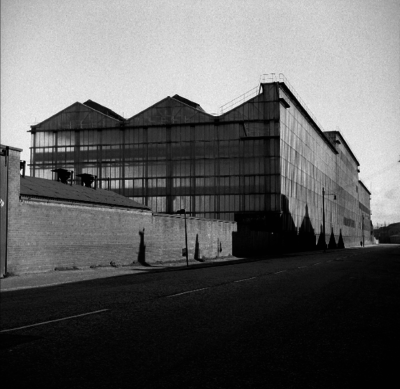
The Clyde Foundry, 184 Helen Street, Govan, 1967.
Taken during its demolition in 1967, this view shows all that remained of a very extensive iron-foundry (clad in reinforced glass). It was the largest building of its kind in Scotland. Built in 1922 for shipbuilders Harland & Wolff of Belfast to make components for marine diesel engines for the company works in Belfast and Finnieston. The firm built up a presence on the Clyde from 1912, with a shipbuilding yard in Govan, and a diesel engine works in Finnieston, as well as existing facilities. The company withdrew from the Clyde in 1962, and its works were demolished.
Photo: John R Hume. Yashika 635 twin-lens reflex camera, digital print
End of the Line Photographs of Glasgow's Industrial Past by John R Hume
-
Introduction
-
The Regent Flour Mills, Bunhouse Road, Kelvingrove, 1967.
-
The United Cooperative Baking Society’s bakery, 12 McNeil Street, Moffat Street frontage, 1967.
-
The Cranstonhill Bakery, 38-42 Cranston Street, Anderston, 1967.
-
The South Sawmillfield Cotton Mill, 6-12 Burns Street, Port Dundas, 1965.
-
The Saracen Foundry, 73 Hawthorn Street, Possilpark, 1965.
-
The Gorbals Grain Mills, 87-97 Surrey Street, Gorbals, 1966.
-
Townsends’ Chemical Works, 31-33 Townsend Street, Port Dundas, 1967.
-
The Anderston Cotton Work, 93 Cheapside Street, Anderston, 1966.
-
Monumental Sculptors’ Works, 60 Cathedral Street, Townhead, 1967.
-
Pointhouse Shipbuilding Yard, 250 Ferry Road, 1964.
-
Reed and Heddle Factory, 105-111 John Street, City Centre, 1973.
-
The Clyde Foundry, 184 Helen Street, Govan, 1967.
-
Parkhead Forge, G Shop, East Wellington Street, Parkhead, 1967.
-
Concluding Remarks